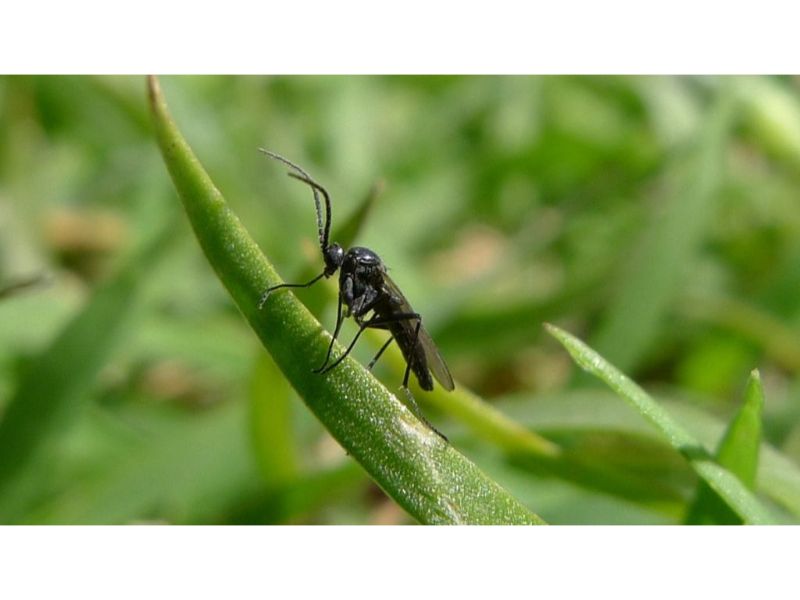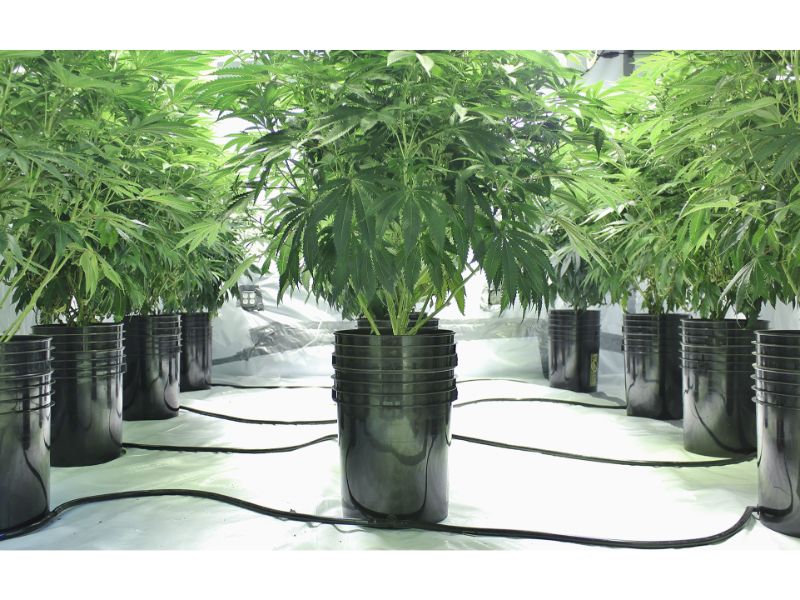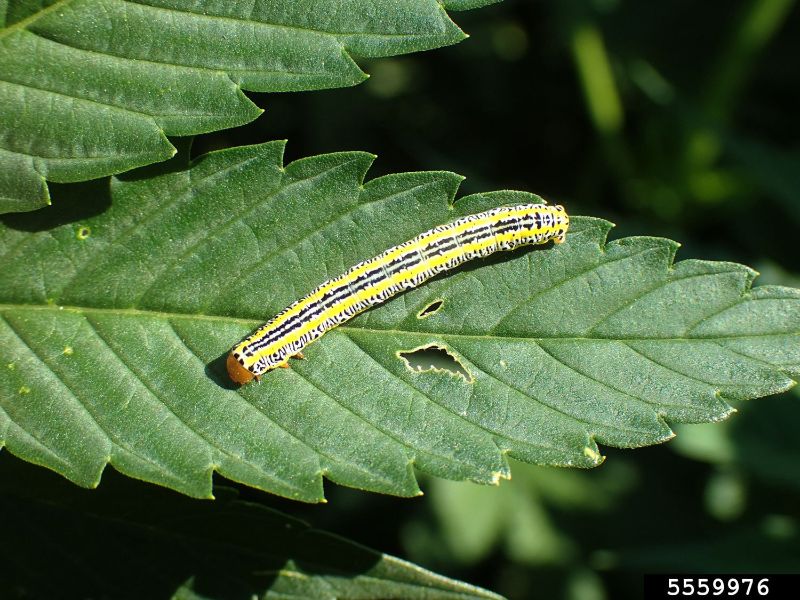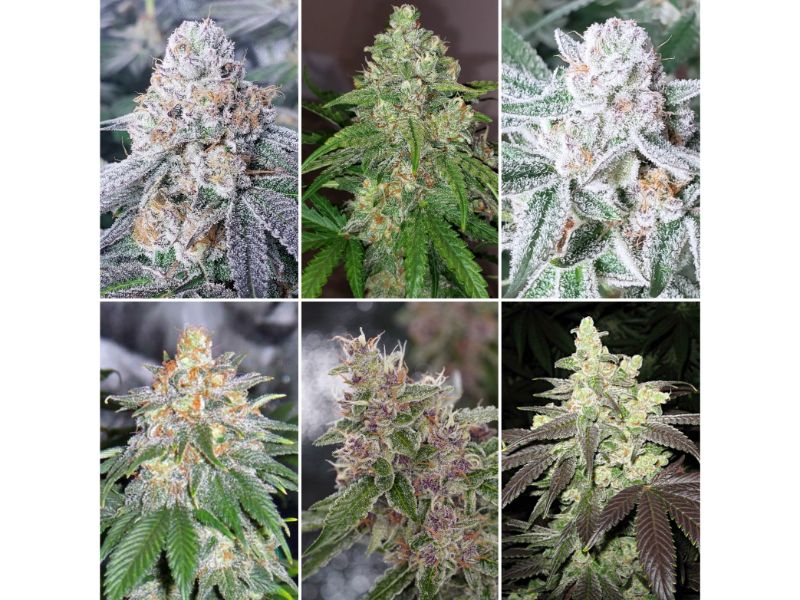When growing cannabis (or other herbs) you will often notice some very tiny flies buzzing around your plants. However identifying them can be hard because there are many creatures that look like “tiny flies”. BUT if you see them flying (and even landing) on your soil most of the time, you can be sure that you are dealing with: Fungus Gnats!
Fungus gnats are tiny flying insects that are about 2mm long. Mostly they are dark/brown while looking a bit like mosquito’s. They are a pain in the ass when it comes to growing cannabis because once the circumstances are right, they lay egg’s in your soil. When these egg’s hatch, the larvaes/maggots come out and start eating micro parts of fungus and decaying matter. While doing this, they also damage the roots of the plant.
This damage will cause leaf problems and reduce the growth badly. It is even possible that a nasty Gnat infestion kills a complete cannabis plant!
Fungus Gnats are named that way because they eat very small pieces fungus. Next to that they love wet and warm conditions because that produces fungus and is necessery to lay egg’s in. The soil of your cannabis plant is a perfect spot that meets these circumstances. Especially when watering too much, there is a great chance that there will be fungal growth (not visible to eye) that attracts these gnats.
How to recognize a Fungus Gnat infestation?
Recognizing a fungus gnat infestation can be quite tricky sometimes as the plants won’t show any signs in the beginning of the infestation. You really have to focus on the gats themselves as they are flying and laying egg’s around your plants.
Well spotting them is not that hard when you take care and watch your plants on a daily base. They will be flying/crawling around your plants and mostly pay interest to the wet soil beneath them.
However this doesn’t mean that every flying bug buzzing around your plant is a “Fungus Gnat”. It often happens that people mistake Fungus Gnats with fruit flies. This is because they look and act like each other but it’s important to keep them apart:
The man difference between them is their colour and size. Fruit flies are brown instead of clack and in general, fruit flies tend to be a little bigger. Another great difference are the thing sthat they are attracted to.
If you are spotting fruit flies in your growroom/around your plants, it means that somewhere they smell (rotten) fruit or other types of food. The only way to get rid of them is by removing that piece of fruit/food. Fungus Gnats, on the other hand, will be attracted to microscopic pieces of fungus and wet soil.
Larvaes
Another way to recognize a fungus gnat infestation are the maggots/larvaes that will hatch from their egg’s. These are the harmfull creatures of this species that will eat the roots and eventually harm your plants badly. You will find them in or on the soil because that is where they hatch and live for the first few weeks.
On this picture you can see the larvae pretty good thanks to the close-up, however in real life they are very small and you will only see them as tiny dots wriggling around on the upper layer of your soil.
Plant damage due Fungus Gnats
If you wait too long before treatment or you simply didn’t notice them, it’s a matter of time before these larvaes will harm the roots of your plant. Only once this happens, you wil start seeing signs on the plant itself. The problem is that these signs are very similair to signs of others problems like:
- PH problems
- Overwatering
- nutrient deficinecies
This makes it almost impossible to find out if it is being caused by fungus gnats or something else. We do not recommend to look at this when trying to find fungus gnats. The following pictures will show some plant damage by fungus gnats, you’ll see what I mean:
How to treat Fungus Gnats on your cannabis plants?
There are multiple easy options that will help you to get rid of Fungus gnats, but you know what they say: “Prevention is better then cure” and thats why we take a look at prevention methods first:
First of all: Never over-water your plants. This is the most important prevention for fungus gnats as they hate dry environments and won’t lay egg’s in dry soil. Next to prevention, this is also effective to get rid of them once they are already there. (No water = No fungus and no fungus = no fungus gnats).
If your are growing with LED’s, it might be trickier to keep the top layer of the soil dry. In that case it might help to get a table-fan directly blowing at the soil.
Yellow sticky cards around the growing area
This is an old trick but works pretty good! Fungus Gnats loves everything that has a bright, yellow colour and will fly towards it once the see it. This is why most gardening stores sells these yellow sticky cards that will trap the fungus gnats using a layer of glue.
Next to that, it’s a great tool to check on how big of a infestation you are dealing with. If your treatment methods are effective, you willl see a decreased amount of fungus gnats appearing on these cards! Make sure to keep them up untill all fungus gnats are gone.
Options of eliminating the larvaes in the soil
Once their egg’s have been hatched and their larvaes are harming your plant, it’s time for drastically measures! There are multiple effective ways to get rid if living larvaes in the soil, here is a list of our favourites:
Neem-oil
Using a sprayer to treat the upper layer of your soil with neem-oil can be very effective to kill these larvaes. This oil is safe to use on your plants up untill a few days before harvest. Next to that make sure you won’t spray it on the buds as it could have a negative influence on the smell/taste. Spray this stuff everywhere there are larvaes and it should kill them right away!
Neem-oil is 100% natural and able to treat lot’s of bugs that are dangerous for your cannabis plants. So having this stuff around is recommended!
Diatomaceous earth
Diatomaceous earth is often being used as a very effective insecticide while being 100% harmfull for humans (You could even consume it). This organic insect-killer is made out of fossilized shells and very sharp to tiny insects. Once they touch or eat it, it will puncture their exo-skeletons leading to the drainage of their body fluids. Diatomaceous earth is very effective and works with most insects.
BT-bacteria
Another easy way to treat the larveas that are living in your soil is by watering the plants with a type of bacteria called: “BT-bacteria” (Bacillus thuringiensis var israelensis). They come in a package filled with small chunks that needs to be crushed before mixing them with water. Make sure to measure you PH-levels afters mixing this stuff!
*Make sure you get the right one (There is also a BT-bectaria meant to use on caterpillars)
As you can see, there are multiple options to treat this persistent little fly. However the most important thing to do is not over-watering your plants!Not only does this attract Fungus Gnats but it also could harm your plants in many other ways.







